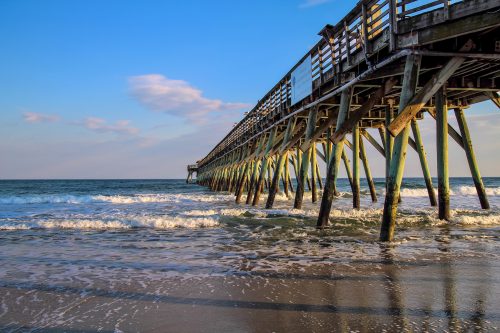What do Cincinnati, Miami, and Birmingham have in common when it comes to immigration? Their populations grew dramatically because of immigration. In fact, in each of these metro areas, over 87 percent of population growth between 2014 and 2017 was attributable to new immigrant residents.
New American Economy first released Map the Impact, featuring data on every congressional district, all 50 states, and 100 of America’s largest metro areas, three years ago. Today, we are releasing our latest city data, showing how immigrants contribute by paying taxes, creating jobs, and supporting key industries. Why put a spotlight on metro areas? Simply put, cities are where immigrants tend to concentrate. In 2017, 85 percent of all immigrants in the United States lived in the top 100 metro areas. Past research has already found that immigrants are critical to keeping large metro areas growing and vibrant. Now with several years of data, we can see how much immigrants contribute to helping cities grow.
We find:
- From 2014 to 2017, immigrants contributed to nearly 33 percent of total population growth in the top 100 metro areas.
- In fact, 12 metro areas would have shrunk without immigrants, including Philadelphia, Detroit, and San Jose.
- Some metro areas saw a significant increase in the number of immigrant entrepreneurs. For example, in the Baton Rouge metro area, the number of immigrant business owners more than doubled from 1,450 to more than 3,000 just between 2014 and 2017.
- As baby boomers retire in large numbers, and U.S. healthcare needs increase, immigrants are filling crucial healthcare roles. In 18 metro areas, healthcare was one of the top five industries for immigrants. In metro El Paso, foreign-born workers made up one in three healthcare workers in 2017 and in 11 metro areas, immigrants made up more than 1 in 10 healthcare workers.
- Homeownership among immigrants is on the rise in 88 of the top 100 metro areas. The total number of immigrant homeowners rose from 7.3 million to 8 million, an increase of 9.5 percent between 2014 and 2017. In 22 metro areas, the number of immigrant homeowners increase by more than 10,000 in just those three years.
Table 1: Top 10 Metro Areas by Largest Share of Overall Population Growth, 2014-2017, Attributable to Immigrants
| Metro Area | Share of Growth Attributable to Immigrants |
| Cincinnati, OH-KY-IN | 98% |
| Birmingham-Hoover, AL | 88% |
| Miami-Fort Lauderdale-West Palm Beach, FL | 87% |
| Baton Rouge, LA | 79% |
| Seattle-Tacoma-Bellevue, WA | 59% |
| Grand Rapids-Wyoming, MI | 57% |
| San Francisco-Oakland-Hayward, CA | 56% |
| Greenville-Anderson-Mauldin, SC | 56% |
| Sacramento-Roseville-Arden-Arcade, CA | 54% |
| New York-Newark-Jersey City, NY-NJ-PA | 53% |
Along with their new and diverse perspectives, new arrivals bring their skills and entrepreneurial spirit to cities, fueling economic growth for all residents. In 2017, the 37.8 million immigrants who lived in the top 100 metro areas made up about 17.4 percent of their overall population. As workers, they serve as engineers designing machines in advanced manufacturing in Cincinnati, small business owners running grocery stores in Birmingham, and construction laborers building new homes in Miami.
Meanwhile, as consumers and taxpayers, immigrants are pumping billions of dollars into the local economies. In 2017 alone, immigrant households earned $1.3 trillion in income and held $973 billion in spending power in the top 100 metro areas combined, supporting local businesses from clothing shops to electronics stores to restaurants. Furthermore, in these metro areas, immigrants paid a total of nearly $361 billion in taxes, including more than $250 billion in federal taxes and $110 billion in state and local taxes, supporting local public services such as hospitals and schools.
Table 2: Top 10 Metro Areas by Total Taxes Paid and Spending Power Held by Immigrant Households, 2017
| Metro Area | Taxes Paid by Immigrants | Immigrants’ Spending Power |
| New York-Newark-Jersey City, NY-NJ-PA | $69.2B | $162.3B |
| Los Angeles-Long Beach-Anaheim, CA | $38.2B | $108.6B |
| San Francisco-Oakland-Hayward, CA | $22.1B | $51.9B |
| Washington-Arlington-Alexandria, DC-VA-MD-WV | $17.2B | $43.6B |
| Chicago-Naperville-Elgin, IL-IN-WI | $16.8B | $44.7B |
| Miami-Fort Lauderdale-West Palm Beach, FL | $16.1B | $52.1B |
| San Jose-Sunnyvale-Santa Clara, CA | $15.0B | $33.2B |
| Houston-The Woodlands-Sugar Land, TX | $13.8B | $41.6B |
| Boston-Cambridge-Newton, MA-NH | $11.2B | $28.0B |
| Dallas-Fort Worth-Arlington, TX | $10.6B | $33.2B |
Critically for some metro areas, immigration was the determining factor between growth and decline. Among the top 100 metro areas, 12 would have shrunk without growth in their immigrant population between 2014 and 2017.
In Philadelphia, for example, immigrants have become a key driver of its population growth. Without the influx of immigrants, the Philadelphia metro area would have shrunk by more than 13,000 people. Philadelphia’s proactive welcoming policies, as well as its lower cost of living compared to other major cities like New York, have made it an attractive pace for immigrants and native-born Americans alike. Its overall population grew by nearly 47,000 people between 2014 and 2017.
Table 3: Metro Areas Where Immigrants Helped Reverse Population Decline, 2014-2017
| Metro Area | Population Change, Without Growth in Immigrant Population | Actual Population Change |
| San Jose-Sunnyvale-Santa Clara, CA | -17,036 | 45,017 |
| Detroit-Warren-Dearborn, MI | -15,350 | 19,292 |
| St. Louis, MO-IL | -14,315 | 2,050 |
| Philadelphia-Camden-Wilmington, PA-NJ-DE-MD | -13,361 | 46,911 |
| Bridgeport-Stamford-Norwalk, CT | -8,455 | 4,216 |
| New Haven-Milford, CT | -4,920 | 406 |
| Buffalo-Cheektowaga-Niagara Falls, NY | -3,524 | 314 |
| Albany-Schenectady-Troy, NY | -2,747 | 2,031 |
| Baltimore-Columbia-Towson, MD | -2,331 | 22,188 |
| Memphis, TN-MS-AR | -2,182 | 112 |
| Dayton, OH | -1,902 | 644 |
| Omaha-Council Bluffs, NE-IA | -159 | 9,761 |
These new Americans are arriving in cities at a time when baby boomers are retiring en masse. Between 2014 and 2017, all but two of the top 100 metros had an increase in the share of their U.S.-born population aged 65 and above. Not only has this led to greater workforce needs as boomers retire, but it has also triggered a surging demand for healthcare support services.
Immigrants are uniquely positioned to help these aging communities. In all of the 100 metro areas, they are more likely to be working-age compared to their U.S.-born counterparts. As active workers in the labor force, immigrants contribute to entitlement programs like Medicare and Social Security and help fund other social services that support senior citizens.
Meanwhile, immigrant workers also provide the medical care and personal assistance much needed by older populations. In 18 metro areas, healthcare appears as one of the top five industries in which immigrants played an outsize role in 2017. In El Paso, Texas, for example, foreign-born workers made up one in three healthcare workers. In 11 metro areas, immigrants made up more than 1 in 10 healthcare workers.
Table 4: Share of Foreign-born Healthcare Workers in Select Metro Areas, 2017
| Metro Area | Share of Healthcare Workers, Foreign-Born |
| El Paso, TX | 34.0% |
| Minneapolis-St. Paul-Bloomington, MN-WI | 18.5% |
| Worcester, MA-CT | 17.1% |
| Baltimore-Columbia-Towson, MD | 16.2% |
| Tucson, AZ | 15.9% |
| Palm Bay-Melbourne-Titusville, FL | 13.4% |
| Detroit-Warren-Dearborn, MI | 11.9% |
| Springfield, MA | 11.1% |
| Deltona-Daytona Beach-Ormond Beach, FL | 11.1% |
| Columbus, OH | 10.4% |
Immigrants are also breathing new life into local businesses as entrepreneurs. After settling down in places like Seattle or Tampa, many immigrants start their own businesses, creating jobs and making their own contributions to America’s strong entrepreneurship culture. Between 2014 and 2017, the number of foreign-born entrepreneurs grew by 7.7 percent in the top 100 metro areas alone, from 2.6 million to 2.8 million.
Table 5: Top 10 Metro Areas with Fast-Growing Number of Immigrant Entrepreneurs Between 2014 and 2017
| Metro Area | Number of Immigrant Entrepreneurs, 2017 | Change from 2014 |
| Baton Rouge, LA | 3,008 | 107.40% |
| Tulsa, OK | 3,665 | 65.70% |
| Kansas City, MO-KS | 9,625 | 55.40% |
| Richmond, VA | 8,992 | 50.90% |
| El Paso, TX | 16,298 | 50.50% |
| Tampa-St. Petersburg-Clearwater, FL | 33,910 | 47.10% |
| Hartford-West Hartford-East Hartford, CT | 9,518 | 39.50% |
| Seattle-Tacoma-Bellevue, WA | 54,318 | 39.00% |
| Minneapolis-St. Paul-Bloomington, MN-WI | 20,413 | 34.50% |
| Fresno, CA | 11,028 | 32.10% |
Across the largest 100 metro areas, homeownership among immigrant residents is also on the rise, contributing to increased housing wealth in the country. The number of immigrant households who owned their homes rose from 7.3 million to 8 million, an increase of 9.5 percent, in the top 100 metro areas between 2014 and 2017. All in all, 22 metro areas saw the number of immigrant homeowners increase by more than 10,000 in just those three years. These new homeowners not only support local housing markets but also make major contributions through property taxes, further expanding local taxes bases that fund local programs and services.
Table 6: Top 10 Metro Areas with Fast-Growing Number of Immigrant Homeowners Between 2014 and 2017
| Metro Area | Immigrant Homeowners, 2017 | Change from 2014 |
| Nashville-Davidson-Murfreesboro-Franklin, TN | 30,573 | 35.4% |
| Oklahoma City, OK | 23,759 | 32.7% |
| Charlotte-Concord-Gastonia, NC-SC | 55,946 | 31.8% |
| St. Louis, MO-IL | 35,440 | 28.4% |
| Portland-Vancouver-Hillsboro, OR-WA | 73,663 | 26.8% |
| Seattle-Tacoma-Bellevue, WA | 166,233 | 26.7% |
| Denver-Aurora-Lakewood, CO | 79,674 | 24.9% |
| Raleigh, NC | 38,509 | 24.6% |
| Austin-Round Rock, TX | 68,674 | 22.9% |
| Las Vegas-Henderson-Paradise, NV | 114,138 | 22.2% |
Across the top 100 metro areas in the United States, from the smallest, Spokane, Washington, to the largest, New York City, immigrants are helping cities grow in myriad ways. They serve as healthcare workers filling critical labor gaps and caring for seniors, entrepreneurs creating local jobs, consumers patronizing local businesses, homeowners strengthening local housing markets, and taxpayers funding public services.
This new data shows that making cities more accessible and welcoming to immigrants will benefit not only the immigrants themselves, but also the communities where they live.




